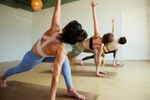I’m all for moving the body, ideally, multiple times a day. Frequently getting up from the screen to stretch the legs, going for a regular long walk, tending your garden, it’s all good. Movement is one of the cornerstones of a long and healthy life, not to mention one of the underrated joys of everyday life, a reliable mood-lifter. But many people, and certainly many of my health-conscious patients, want to push beyond the everyday stuff and engage in a more structured program that challenges the body a little (or a lot) more vigorously. We call that exercise and I’m fine with it, whether we’re talking endurance exercise (let’s say, a morning jog or swim) or strength exercise (either inside or outside the gym) or engaging in a sport, a racquet sport for instance, that can develop both cardiovascular fitness and strength.
But here’s the catch: when we challenge our bodies more intensely, to get greater health benefits or just for the fun of it, we increase the risk of injuring ourselves which obviously defeats the whole purpose. The good news here is that with some planning and observing some basic (but oh so easy to ignore) rules of the road, we can sidestep much of that risk, upping our odds of enjoying a vigorous old age, delaying frailty for as long as humanly possible.
On your mark, get set, go!
Maybe when you were a kid, you could “get off the couch” and launch into a full sprint and think nothing of it. If you are over 30, rest assured, those days are gone, or soon will be. As we age, our muscles lose water (which is what they’re mostly made of) and suppleness. Our connective tissue – our tendons and ligaments – is made up of a springy, shock-absorbing tissue called collagen which ages along with us as well, growing progressively drier and less flexible. Don’t be overly alarmed. All this stuff still works, it just requires some TLC before you ask too much of it.
Update your warm up/cool down
Remember the traditional routine of beginning a work-out by stretching, using some “static” stretches where you hold a stretch pose for 15 or 20 seconds, pushing the muscle to the point of discomfort. Well forget that. The right way to get moving is to slowly warm up the muscles and the connective tissue. Usually, that will consist of doing a version of the exercise you’re about to do, say for 5 or 10 minutes, at a relaxed pace.
So, for a jog, begin with a brisk walk; if you’re swimming or cycling, go slow at first and then pick up speed. Inside the gym, you might get started with a light spin on a cardio machine. (If you’re doing a strength work-out, begin with lighter-than-normal weights or less resistance, at a faster pace). This warm-up does just that, raising the body temperature and increasing the blood flow to the muscles, prepping them for the bigger effort to come. And then at the end of the work-out, power down in the same way for 5-10 minutes, allowing heart rate and blood pressure to drop back to normal.
What about stretching?
The research isn’t definitive that stretching helps prevent sport injuries but a lot of people do seem to benefit, witness the surge in popularity of dedicated stretching studios. Likely the most reliable form of stretching to incorporate into a work-out are “dynamic” stretches, usually done after the warm-up, where you push your muscles and joints through a full range of motion, without strain. For instance, you might extend your arms out straight out from the side and move them around in expanding circles. You can do something similar with the legs, from a standing position, making circles with each extended leg, one leg at a time of course. But there are no hard and fast rules here. Some of my patients like to do a few simple yoga poses to loosen up, for instance a cat-cow pose to relax tension in the lower back.
Fascia: the foam roller story
If you take the time and effort (and really, it isn’t much) to warm and loosen up, you’ve significantly reduced the chances of being saddled with a muscle strain (“pulling a muscle”) or pain around an overworked muscle tendon, for instance, so-called Achilles tendonitis or, an upper-body complaint, “tennis elbow.” But there are other less appreciated but just as common problems caused by the fascia, a tough membrane that acts as a casing for the entire muscular system. When the fascia is working properly, it allows the muscles to move smoothly around each other. When it tightens up, it causes pain and restriction of movement and can throw off your entire gait. Stretching doesn’t usually go deep enough to “release” gummed up fascia. Here, some form of targeted deep-tissue massage can be the ticket, but a great DIY approach is to incorporate a session with the foam roller, for 5-10 minutes, at least a few times a week. Work with a physical therapist or go on-line to pick up the technique, then roll those muscles (upper body as well as lower: quads, glutes, calves, deltoids, pecs). The tighter your muscles, the more you need the roller, and the more the pressure of the roller will feel intense, even somewhat painful. Trust me, it’s worth it.
The sauna solution
For all the good it does, vigorous exercise can promote a lot of muscle inflammation and the sauna is a pleasurable way to combat that, stimulating healthy circulation and a robust immune system response to boot. You don’t have to incorporate the sauna into every work-out, but if you can manage one or two a week, your body will thank you. Infra-red saunas are an especially good choice – the heat directly penetrates the body so the air doesn’t need to be warmed up to oven temperature as with traditional saunas.
Mix it up
One of the most common mistakes exercisers make is to do the same thing, over and over. Don’t get me wrong, having a regular “thing”, for instance, a swim or a jog or cycle several times a week, is a plus. You’ve internalized a routine, without having to conduct an internal debate every day about whether you’re really in the mood to work out. But please, mix it up! (Or, to use the lingo, cross-train.) Throw in a couple of different exercise activities every week, to complement your regular “thing.” That way, you’ll stay fresher, both mentally and physically. You stave off the boredom of “same old, same old” and you challenge your muscles and joints in different ways, lessening the chances of suffering an overuse or “repetitive stress” injury by stressing the system in exactly the same way every time. Activities like gym climbing or an exercise class or yoga or tai chi class are great because they’ll throw different types of physical challenges at you in the course of a single work-out.
Listen to your body
I get it. People can fall in love with exercise because they’re delighted with the physical changes they’re seeing or the sense of accomplishment that comes from getting stronger and more proficient. But all that enthusiasm can sometimes cause them to overlook one very important rule: listen to your body. If you’re feeling pain or achiness that goes beyond next-day muscle soreness, that’s your body telling you to back off and reassess your program. Or, at the very least, pay more attention to warming up, stretching and foam rolling. What you don’t want to do to go on a regular Advil diet to mask the discomfort. That will just lead to more serious injury down the road, and well as invite some ibuprofen (or naproxen or whatever) toxicity issues if you stay on the NSAIDS, week after week.
Start slow, increase gradually
Even if your body hasn’t sent you a warning message (we call it pain), avoid the temptation to rapidly ramp up the demands of your exercise program, either by increasing the duration of the sessions, their frequency or how hard you push. Sooner or later, you’ll cross a threshold and your body will rebel, because you haven’t given your muscles and joints adequate time to adjust before you up the load. Working with a trainer is an excellent way to map out a work-out plan but the general rule of thumb is, don’t ramp up until you can handle what you’re doing now without undue strain.
It’s all about recovery
The older we get, the more important recovery after exercise becomes. That’s called reality. The work-outs that you could handle with ease in your teens or twenties are likely to overtax your system by your thirties and beyond, leading to classic symptoms of overtraining: fatigue, chronic muscle soreness, low mood and yes, increased susceptibility to injury. Make sure to build in at least a couple of rest days into your weekly schedule and remember, it can be an active form of rest, like a relaxing long walk. A special word here for runners: The cardiovascular benefits of running are undeniable but running does demand a lot of the body. (The number of my patients with running-related injuries attest to that.) My advice is, unless you’re in training for competition, don’t run more than every other day, and consider mixing up running with walking, even in the course of a single work-out, to give those leg muscles and tendons a chance to recover. Also, change your running shoes on the regular, at least, every six months (the soles lose their springiness pretty quickly if you’re putting in a lot of miles) and pay attention to your running form. An experienced coach can come in handy here.
Back to basics
The more you push your body, in everyday physical activity or with an exercise program, the more important the lifestyle basics are, to keep the system as resilient as possible. You probably know where I’m going here. Good sleep is a must, as is a healthful diet. High carb processed foods are a no-go and make sure you get plenty of high-fiber veggies to your microbiome and fight inflammation from the inside out. And of course, don’t forget to hydrate! In short, movement improves everything: your metabolism and your microbiome, your sleep and all your body rhythms, your immunity, your stress response, and the overall balance in your life – so move as much as possible and keep it injury-free.




